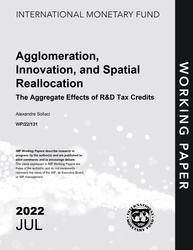
Agglomeration, Innovation, and Spatial Reallocation: The Aggregate Effects of R&D Tax Credits
Agglomeration, Innovation, and Spatial Reallocation: The Aggregate Effects of R&D Tax Credits
READ MORE...
Volume/Issue:
Volume 2022
Issue 131
Publication date: July 2022
ISBN: 9798400212666
$20.00
Add to Cart by clicking price of the language and format you'd like to purchase
Available Languages and Formats
| English |
Prices in red indicate formats that are not yet available but are forthcoming.
Topics covered in this book
This title contains information about the following subjects.
Click on a subject if you would like to see other titles with the same subjects.
Labor , Economics- Macroeconomics , Money and Monetary Policy , Economics / General , Demography , agglomeration , innovation , R&D tax credits , R&D activity , R&D subsidy , R&D tax credit rate , aggregate outcome , Tax allowances , Credit ratings , Productivity , Wages , Global , elasticity of agglomeration , welfare effect , elasticity of congestion
Summary
I investigate the aggregate effects of R&D tax credits in the US. Because it subsidizes R&D activity and because credit rates vary between states, this policy has both spatial and dynamic effects on the economy. To address this issue, I construct an endogenous growth model with spatial heterogeneity and agglomeration spillovers in innovation. Aggregate outcomes in this model are thus affected by the spatial distribution of the population in the economy, which is itself endogenous and reacts to policy. I use this framework to identify a set of local R&D subsidies that maximize aggregate welfare.
Copyright © 2010 - 2025
Powered by:
AIDC



